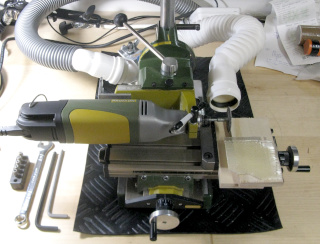Since it resides in my room where I do all kinds of other stuff as well, I needed some way to keep dust from billowing all over the place. Anything involving wood, for example, would produce an infinite amount of fine wood dust, hanging around in the air until it coats every surface in my room. Cleaning up around my multitude of electronic equipment and books and stuff would be a total pain! An even greater pain would be having shards and needles of fiberglass or carbon fiber all over the floor, ergo in the soles of my feet as well!
So I've built myself a dust collection system to use while milling and grinding. Two alternative versions, in fact. The most important component in it is a dirt cheap, second-hand, common domestic vacuum cleaner. All the rest is just plywood and plumbing supplies, dirt cheap as well.



